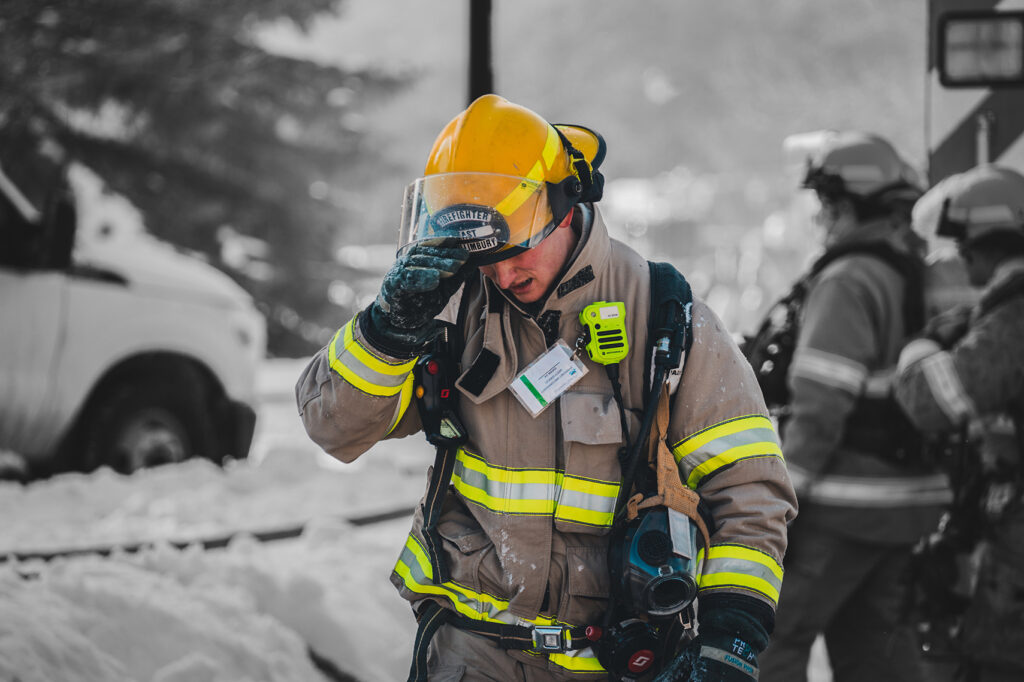As part of Canada’s National Action Plan on Posttraumatic Stress Injuries, PSPNET provides and evaluates internet-delivered cognitive behavioural therapy (ICBT) for current and former public safety personnel (PSP) and their spouses or significant others.
Tailored to the unique challenges PSP and their families face, PSPNET offers both therapist-guided and self-guided course options.
Therapist-Guided Online Courses for PSP
Our therapist-guided courses are currently available to PSP residing in New Brunswick, Nova Scotia, Ontario, Prince Edward Island, Québec, and Saskatchewan.

Therapist-Guided PSP Wellbeing Course
This course teaches simple but effective cognitive behavioural therapy skills to manage symptoms of anxiety and depression.

Therapist-Guided PSP PTSD Course
This course teaches skills for PSP specifically focused on managing symptoms of trauma and posttraumatic stress (no diagnosis required).

Therapist-Guided PSP Sleep Course
This course teaches simple but effective cognitive behavioural therapy skills for improving sleep quality.
Self-Guided Online Courses for PSP and their Spouses

Self-Guided PSP Wellbeing Course
This course assists PSP with preventing or managing stress and mental health symptoms.

Self-Guided Spouse or Significant Other Wellbeing Course
This course supports spouses and significant others in managing their own stress and mental health concerns, which can be influenced by the unique challenges of being a PSP family member.

Self-Guided PSP Sleep Course
This course teaches simple but effective cognitive behavioural therapy skills for improving sleep quality.
Unsure where to start? Take our questionnaire and we will provide some suggested resources and courses.
Sleep Difficulties
What are Sleep Difficulties?
Sleep difficulties refer to a range of problems that impact a person’s ability to fall asleep, stay asleep, or achieve a restful sleep. Some common sleep difficulties include insomnia, excessive daytime sleepiness, sleep deprivation, and sleep interruption or fragmented sleep. Research has shown that in the general public, 1 in 2 people share they have difficulties with sleep at least a few days a week. In the PSP population, sleep difficulties are even more prevalent and may be influenced by shift work, trauma exposure and physical demands of the job. If you are interested in more education and strategies to improve your sleep, The Sleep Course may be a beneficial next step. You can also download the Sleep 101 Resource for some quick tips.
Anxiety
What is Anxiety?
Anxiety is a natural emotion that involves distress, fear, or worry about a potential negative outcome. It can cause feelings of unease, apprehension, and physical symptoms like headaches, stomach issues, or muscle tension to name a few.
In small doses, anxiety can enhance performance, such as motivating us to study for a test or stay alert to potential dangers. However, anxiety becomes a disorder when it persists over time and interferes with daily life and wellbeing.
Generalized Anxiety Disorder (GAD)
What is GAD?
Generalized Anxiety Disorder (GAD) is characterized by excessive, uncontrollable, worrying and feeling anxious or tense about several events and activities (e.g., work, finances, relationships, health). To receive a diagnosis from a mental health professional, these symptoms must persist for at least 6 months.
GAD vs. Worry
GAD is more than just occasional worry. While everyone worries from time-to-time, individuals with GAD find that their anxiety significantly disrupts their daily lives. They may try to manage their worry by repeatedly visiting doctors, seeking constant reassurance from others, over-preparing for challenges, reminding others about tasks, avoiding new activities, or turning down opportunities to prevent additional worries.
Social Anxiety Disorder (SAD)
What is SAD?
Most people experience some degree of shyness at times, but for those with Social Anxiety Disorder (SAD), this anxiety is much more intense and significantly impacts daily life. Individuals with SAD feel considerable fear and anxiety in social or performance situations, particularly when facing unfamiliar people or settings. They fear being judged or scrutinized, which often leads to avoiding social interactions, meeting new people, or taking on new challenges or opportunities. This intense anxiety interferes with their ability to engage in everyday activities.
Panic Disorder (PD)
What is PD?
Panic Disorder involves frequent and unexpected panic attacks in situations that are not dangerous. During a panic attack, individuals experience intense physical symptoms like racing heart, shortness of breath, shaking, and stomach upset, along with fears of losing control, going crazy, having a heart attack, or dying.
What is Panic?
While anyone can experience panic, it differs from anxiety. Anxiety typically involves worry about future events, while panic focuses on intense fear in the present moment. Panic attacks create a sense of immediate danger, loss of control, and helplessness.
Panic attacks can be so overwhelming that individuals may begin to avoid places where they fear a panic attack could occur, potentially leading to a condition called Agoraphobia.
Specific Phobia
What is Specific Phobia?
A person with Specific Phobia (SP) experiences intense anxiety when exposed to a particular object or situation leading to avoidance or significant distress. Symptoms include fear, panic, and physical reactions such as heart palpitations, trembling, sweating, and faintness. Many people with SP recognize that their fear is excessive or unreasonable.
Depression
What is depression and what are the symptoms?
Depression is more than having the blues for a little while. The Canadian Mental Health Association describes this condition as “grappling with feelings of severe despair over an extended period of time.” The symptoms of depression include feelings of hopelessness, worthlessness, restlessness, and excessive irritability. People with depression also experience disruptions like insomnia, oversleeping, slowed thinking and moving, over- or under-eating, loss of pleasure or interest in activities, recurring thoughts of death or suicide, and sometimes unexplained physical problems, as described by the Mayo Clinic.
Depressive Disorders are typically diagnosed when symptoms of depression cause significant distress or interfere with a person’s ability to live their life in a fulfilling way. Who gets Depression?
Who gets depression?
Depression can develop in anyone from across the lifespan. Depression is one of the most common mental health disorders in the general public.
Some risk factors for depression can include hereditary factors, biological factors, the environment, high levels of stress, or physical illness.
Traumatic Stress
What is a Posttraumatic Stress Injury (PTSI) or Operational Stress Injury?
The terms Posttraumatic Stress Injury (PTSI) and Operational Stress Injury (OSI) were created to reduce stigma and recognize mental health challenges as injuries resulting from trauma exposure, rather than mental disorders or diagnoses. OSI refers to mental health issues caused by potentially traumatic events during operational duties, aiming to validate psychological injuries as much as physical ones. While PTSD is one possible outcome, OSI acknowledges that other conditions like depression and panic disorder can also result. To avoid limiting the scope to only operational contexts, PTSI is now used as an umbrella term for psychological injuries from various trauma exposures.
PTSI symptoms can appear immediately or weeks to months after trauma exposure. If symptoms persist for more than a month, it is recommended to seek support.
What is Posttraumatic Stress Disorder (PTSD)?
Posttraumatic Stress Disorder (PTSD) is a mental health condition that can develop after exposure to a real or perceived threat, either directly or indirectly. Chronic exposure to traumatic events can have similar effects. If symptoms persist, worsen, or interfere with daily life for more than a month, PTSD may be diagnosed. However, not all symptoms following trauma indicate PTSD. If you are concerned about your mental health, it’s important to consult with a medical or mental health professional. Some common symptoms include irritability or low mood, concentration difficulties, hypervigilance, withdrawal from others and avoiding reminders of traumatic events.